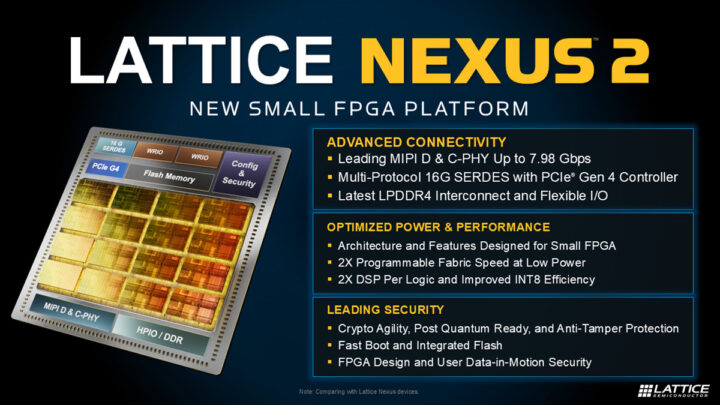Lattice Semiconductors announced several new FPGAs and software tools at the Lattice Developers Conference 2024 which took place on December 10-11. First, the company unveiled the Nexus 2 small FPGA platform starting with the Certus-N2 general-purpose FPGAs offering significant efficiency and performance improvements in this category of devices. The Lattice Avant 30 and Avant 50 were also introduced as mid-range FPGA devices with new capacity options to enable edge-optimized and advanced connectivity applications.
Finally, the company releases new versions of Lattice design software tools and application-specific solution stacks to help accelerate customer time-to-market such for edge AI, embedded vision, factory automation, and automotive designs with Lattice Drive. Let’s have a look at the highlights of each announcement.
Lattice Nexus 2 small FPGA platform and Certus-N2 FPGA
Highlights and benefits of the Lattice Nexus 2 small FPGA platform:
- Power Efficiency against similar class competitive devices
- Up to 3x lower power
- Up to 10x more energy-efficient edge sensor monitoring
- Performance against similar class competitive devices
- Up to 3.2x faster MIPI speed for faster connectivity and data transfer.
- Up to 10x faster configuration time enhancing overall efficiency, fault tolerance, and security in safety-critical applications.
- Connectivity
- Multi-protocol 16G SERDES with PCIe Gen 4 controller
- High-performance I/Os
- High-speed LPDDR4 memory interface
- MIPI D & C-PHY interfaces up to 7.98 Gbps
- Security
- 256-bit AES-GCM and SHA3-512; compliant with FIPS 140-3 level 2 standards
- Crypto agility, post-quantum ready, and anti-temper protection
- Integrated flash for faster and more secure configuration
- End-user options for customers’ data-in-motion security needs
- Form Factor – Up to 5X smaller size
- Manufacturing process – 16 nm FinFET TSMC
The Nexus 2 is a platform enabling the development of small FPGA devices, and the Lattice Certus-N2 is the first (general-purpose) FPGA family leveraging the new platform
Certus-N2 specification highlights:
- System Logic cells – Up to 220k
- Look-up Tables – Up to 135x LUTs
- DSP – Up to 520x 18×18 multipliers
- Memory
- Up to 12 Mbit embedded memory
- LPDDR4/DDR4 interface up to 2400 Mbps
- Up to 8x 16 Gbps multi-protocol SerDes for up to 128 Gbps total bandwidth
- PPL – Up to 7x GPLL
- Security – Bitstream encryption and authentication
- Instant-on: < 20 ms configuration using xSPI flash memory
- Packages – As low as 9×9 mm2 with SerDes; ball-pitch options of 0.5, 0.8, and 1.0 mm
- Available in commercial and industrial temperature grades
Four Certus-N2 small FPGA SKUs are available: CT06, CT10, CT16, and CT20 with key features listed in the table below.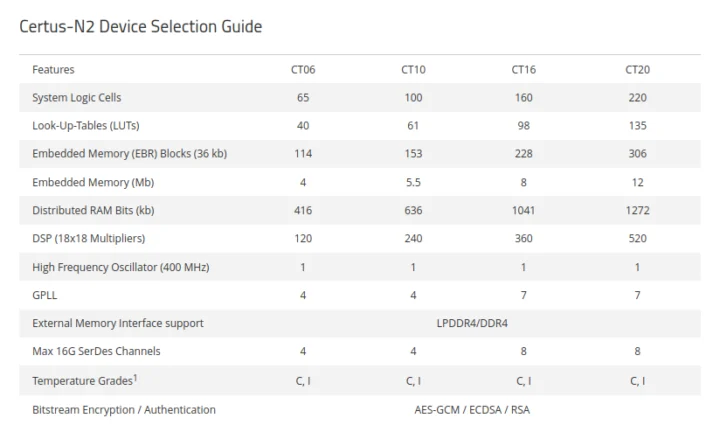
Target applications include industrial Machine Vision with MIPI CSI-2, LVDS, and SubLVDS interfaces, 10GbE networking, automotive zonal controllers/gateways with low latency and flexible Ethernet, and frame grabbers using DMA over PCIe to host PC, 10GbE video input and PCIe output, plus LPDDR4 external memory for buffering.
Additional details may be found on the platform and Certus-N2 product pages.
Lattice Avant 30 and Avant 50 mid-range FPGA devices
The Avant 30 and Avant 50 FPGAs are new parts from the Lattice Avant mid-range FPGA family introduced in 2022 with the launch of the Avant-E FPGAs with three SKUs: Avant-AT-200E, Avant-AT-300E, and Avant-AT-500E. The new FPGA devices are available in the Avant-E, Avant-G, and Avant-X families optimized respectively for Edge computing applications, General-purpose FPGA applications, and Connectivity-focused applications like high-speed networking. They add to the existing Avant 70 parts.
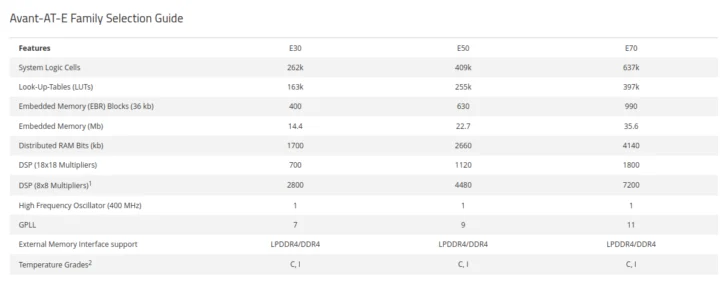
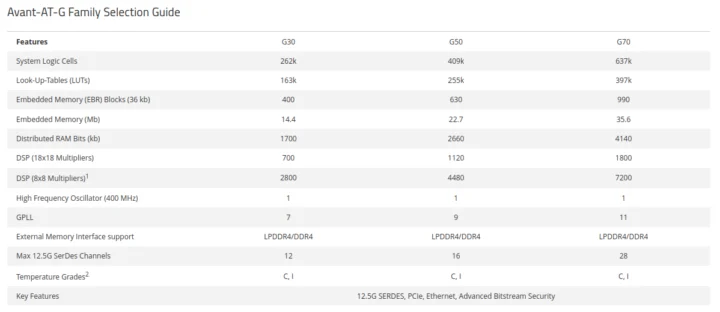
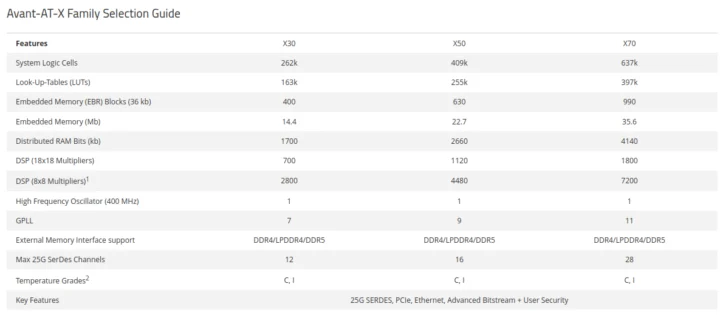
All those parts are typically used for computing, communications, defense, industrial, and medical applications. You’ll find more details on the FPGA products page of the Lattice Semi website.
Lattice tools updates and new software stacks
Besides a new Nexus 2 FPGA platform and new FPGA devices, Lattice Semi also releases new versions of its Lattice Radiant and Lattice Propel software tools. The new versions add support for the Lattice Nexus 2 FPGA platform, Lattice Certus-N2 FPGA family, and Lattice Avant devices, plus new features including RISC-V variants, improved debug, power calculation, and ease-of-use.
To speed up the time-to-market of their customers’ products, the company also released four software stacks for specific applications:
- Lattice sensAI for Edge AI in mobile, smart home, smart city, smart factory, and smart car products.
- Lattice mVision for embedded vision applications such as machine vision, robotics, ADAS, video surveillance, and drones.
- Lattice Automate for factory automation; useful for CNC, robotics, scalable multi-channel motor control with predictive maintenance, real-time Industrial Networking, and Local to Cloud Networking with OPC UA.
- Lattice Drive for automotive designs
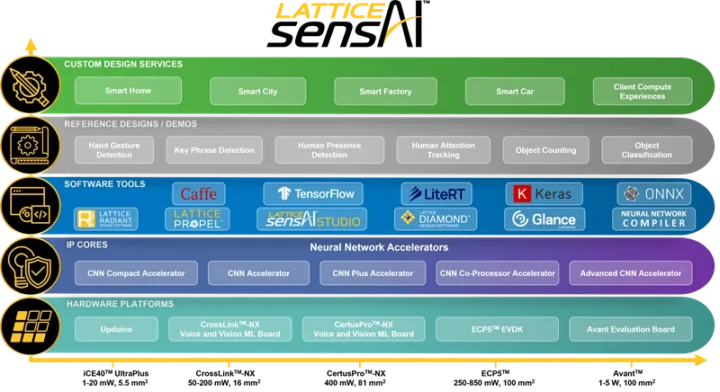
These new software stacks are not just something you can download and try on Lattice Semi FPGA hardware, and you’d need to contact sales to access those. The Radiant and Propel tools can be downloaded for Windows or Linux and used with a free or subscription license depending on your need. You’ll find details about the new tools and software stack on the “Design Software and IP” page of the company’s website
If you missed the Lattice Developers Conference 2024, but would have liked to have attended, most of the video presentations will soon be available on replay.
Thanks to TLS for the tip.

Jean-Luc started CNX Software in 2010 as a part-time endeavor, before quitting his job as a software engineering manager, and starting to write daily news, and reviews full time later in 2011.
Support CNX Software! Donate via cryptocurrencies, become a Patron on Patreon, or purchase goods on Amazon or Aliexpress


